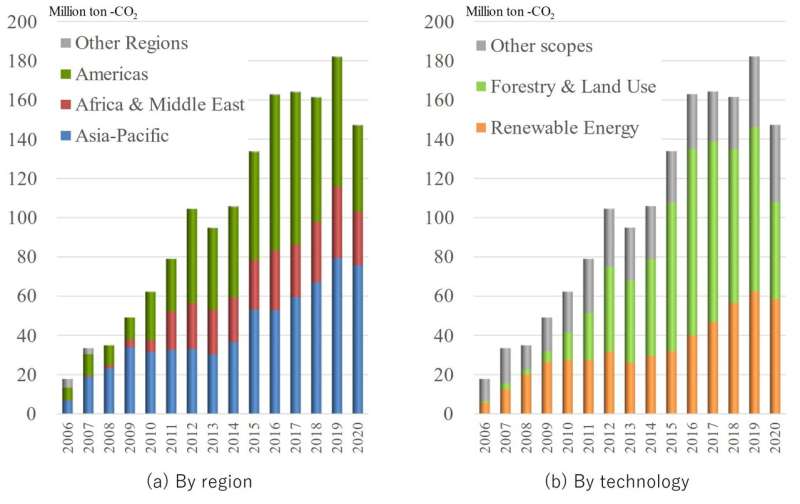This article has been reviewed according to Science X's editorial process and policies. Editors have highlighted the following attributes while ensuring the content's credibility:
fact-checked
trusted source
proofread
Decarbonization dynamics: New analysis unveils shifting trends in the voluntary carbon offset market

As humanity grapples with the fight against climate change, reducing greenhouse gas emissions is urgently necessary. One way to achieve this is through the carbon offset market, where organizations or individuals can buy credits from emissions-reducing projects.
Now, researchers from Kyushu University, Japan, in collaboration with Queensland University of Technology (QUT), Australia, have conducted a worldwide analysis of voluntary carbon offset programs and identified trends into which types of carbon reduction technologies are selected and prioritized. Their findings, published in the journal, Cleaner Environmental Systems, provide important insights for policymakers to improve the effectiveness and credibility of the carbon offset market.
"The carbon offset market is one of the most economically effective means of reducing carbon emissions," says first author Professor Hidemichi Fujii of Kyushu University's Faculty of Economics.
"For many companies, becoming more environmentally friendly is an important priority, but reducing their own emissions may not be economically feasible. Instead, by purchasing carbon offsets, organizations can reduce their carbon footprint for a much cheaper price."
Over the last decade, as demand for carbon offset programs has skyrocketed. But until now, there has been no global analysis into which types of programs are established and why.
In this research, Fujii and Professor Shunsuke Managi from Kyushu University and QUT researchers, Dr. Jeremy Webb, Professor Sagadevan Mundree, Professor David Rowlings, Professor Peter Grace, and Professor Clevo Wilson, analyzed more than 7000 carbon offset programs worldwide from 2006-2020, sourcing data from the Voluntary Registry Offsets Database provided by the University of California, Berkeley.
The researchers split the data by region (the Americas; Africa and the Middle East; the Asia-Pacific, and Other regions) and classified each carbon credit project into three categories: renewable energy like wind and solar; forestry and land management including reforestation and deforestation prevention; and other technologies, such as household technologies and waste management.
The researchers then focused on four indicators to track shifts in the voluntary carbon credit market: PRIORITY, which tracks what percentage of the total carbon credits come from each particular project; SCALE, which measures the total credits issued for each project, IMPORTANCE, which is indicated by the number of projects in each category, and ACTIVITY, which is based on the total number of carbon offset programs.

In forestry and land management, issued carbon credits initially increased due to United Nations-led REDD and REDD+ programs, aimed at reducing deforestation in developing countries. However, after 2016, the priority shifted towards projects such as improving the carbon dioxide absorption in forests, mainly in developed countries, like the United States.
"On the one hand, these nature-positive solutions are very important, as they simultaneously address the problem of climate change and biodiversity loss," says Webb and Wilson. "On the other hand, these projects are much harder to monitor and estimate the resulting carbon capture, leaving the system open for abuse. Additionally, leakage can occur, which is when stronger forestry protections in one country can drive deforestation somewhere else."
Webb and Wilson therefore emphasized the importance of establishing a robust regulatory regime and monitoring framework to ensure the effectiveness and credibility of forestry and REDD+ carbon offset programs in the future.
For renewable energy, the researchers found that in recent years, an increase in carbon credits issued was predominantly driven by wind and solar projects, particularly within the Asian-Pacific region.
"Most voluntary carbon credit projects are in India and China, where electricity shortages and coal-related air pollution have incentivized an increase in renewable energy projects like solar and wind," says Fujii. "Furthermore, the falling costs of these technologies has also boosted their priority."
For the category of other technologies, the researchers found a significant increase in priority for household and community carbon offset projects, mainly due to improved cookstove programs in South Asia and Sub-Saharan Africa. These projects reduce CO2 emissions and improve health and convenience, explaining their growing priority.
In future research, the team plans to introduce new factors into the analysis, such as legal factors and energy market factors.
"Changes in energy market prices and the new laws will likely impact the price and amount of carbon credits issued in the future, so it is very important to apply econometric models to determine causality in order to verify the effects of policy implementation" concludes Fujii.
More information: Hidemichi Fujii et al, Priority change and driving factors in the voluntary carbon offset market, Cleaner Environmental Systems (2024). DOI: 10.1016/j.cesys.2024.100164
Provided by Kyushu University




















